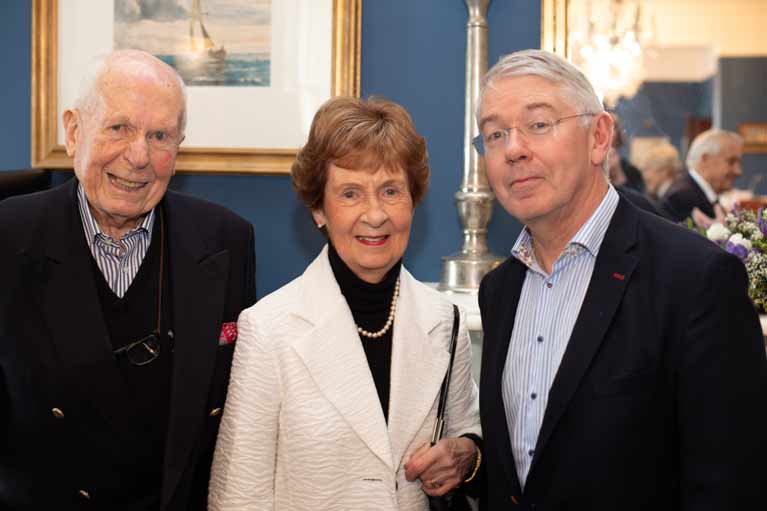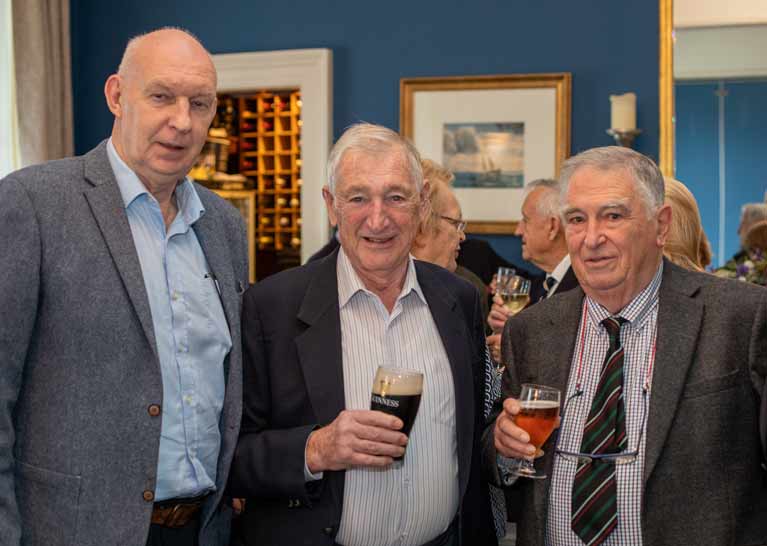Displaying items by tag: 505
With the news that this October's 5o5 World Championships have been cancelled in Bermuda, extra focus is now on Royal Cork's staging of the event in 2022 when the Five-Os come to Cork Harbour.
Michael Quirk, President of the International 5o5 Class Association, announces that the 2021 World Championships scheduled to be held in Bermuda at the end of October, has been cancelled.
Concern over travel issues that competitors may have due to Covid 19 quarantines and the impact of the pandemic on shipping costs led to the decision.
While Bermuda is faring well with only a small number of active cases, no hospitalizations and approximately 75% of the adult population vaccinated, competitors from the Antipodes cannot readily travel and return to their homes. Restrictions and quarantine problems between European countries and concern over potential quarantine requirements from contact tracing led to the view that cancellation was prudent.
The Class looks forward to holding its 2022 World Championships in Cork from August 3 – 13th 2022.
120 crews from over 15 nations are expected for the 2022 championships.
As Afloat previously reported, this will be the fourth time RCYC will have hosted the 505 World Championships, having welcomed visiting crews previously in 1959, 1964 and 1982
More than 120 crews from over 15 nations are expected in Cork Harbour at the Royal Cork Yacht Club when the 2022 5O5 World Championship is hosted in Crosshaven from 1st -13th August 2022.
This will be the fourth time the club will have hosted the 505 World Championships, having welcomed visiting crews previously in 1959, 1964 and 1982.
Founded in 1720, the Royal Cork Yacht Club is the oldest yacht club in the world and the 505 World Championships will form part of the club’s continued Tricentenary celebrations.
The 505 has been established and racing around the world for over 60 years. However, combined with that rich history and past success the Class continues to surprise and remains one of the most successful two-person sailing choice in the world.

Once one of the most popular dinghy classes in Ireland, there was a gathering of 505 sailors at the National Yacht Club on Dublin Bay in 2019 where the fiftieth anniversary of the staging of the European Championships was remembered.
The class is still raced at Monkstown Bay Sailing Club in Cork Harbour both on a one design and PY basis.
 Home of the 505 Worlds - the picturesque village of Crosshaven in Cork is home to the Royal Cork Yacht Club, the oldest yacht club in the world Photo: Bob Bateman
Home of the 505 Worlds - the picturesque village of Crosshaven in Cork is home to the Royal Cork Yacht Club, the oldest yacht club in the world Photo: Bob Bateman
Royal Cork says next year's event is likely to draw the world’s top sailors and past Olympians such as Howie Hamlin (Multiple World Champion in 18ft skiffs, 14 ft skiffs, 5o5s), Mike Martin and Adam Lowry (US Yachtsmen Of The Year 2020), Boris Herrmann (5th 2020/2021 Vendee Globe) and Ian Pinnell (multiple dinghy World Champion).
 (Above and below) Local 505 dinghy racing in Cork Harbour Photos: Bob Bateman
(Above and below) Local 505 dinghy racing in Cork Harbour Photos: Bob Bateman

Other notable events in Royal Cork's celebrations include the hosting of the Topper World Championships in July 2021 and the biennial, world-renowned, Cork Week which will take place in July 2022. Colin Morehead, Admiral of the Royal Cork Yacht Club, commented, “we are proud that such a prestigious regatta will return to Cork. Our priority is to make this an unforgettable regatta for the sailors and fans, leaving a lasting legacy on dinghy sailing in the club and country.”
The 60-year-old design of the 505 has proven to be timeless, with continued innovation and use of the most modern materials ensuring the 505 class remains one of the best dinghy racing fleets in the world. Image courtesy of 505 International Class/Christophe Favreau
 Alex Barry, Event Chairman and 505 sailor
Alex Barry, Event Chairman and 505 sailor
Alex Barry, Event Chairman and 505 sailor, commented, “it’s a privilege for us to be bringing the world’s best sailors to Cork. The event is already generating interest throughout the Irish sailing scene and the local fleet is beginning to build. With many members having sailed in the previous editions of the event in Cork, it’s a great opportunity for sailors young and old to come to Cork and be involved. The 1982 event was the springboard for our own Mark Mansfield who went on to represent Ireland four times in the Olympics, this event will inspire sailors of all abilities throughout the country.”
505 Irish Fleet Reunion Planned at Royal North Ireland
Jackie Patton, chair of RYANI and Donaghadee Sailing Club member, is on a mission. She used to crew a 505 and along with Thomas Anderson, ex 505 helmsman and crew and past Commodore of Royal North of Ireland YC, is organising a 505 Irish fleet reunion on Saturday 25th April in the RNIYC clubhouse at Cultra near Belfast.
The fleet disbanded in the mid-1980s. The well-known sailor and the retired owner of McCready Sailboats chandlery in Holywood, Wic McCready, and Jackie were the last to win an Irish championship. The class is still active in the rest of the UK and internationally.
As reported previously in Afloat.ie there was an august gathering of Irish 505 sailors at the National Yacht Club on Thursday 7th November to commemorate the second European Championships of the class, which was held in Dun Laoghaire in August 1969.
Former 505 sailors came from far and wide across the island of Ireland to remember the championships, which helped build a young and dynamic group who went on to contribute greatly to Irish Sailing over the following 50 years.
Jackie can be contacted at [email protected]
505 Euros Fiftieth Anniversary Celebrated at National Yacht Club
There was an august gathering of Irish 505 sailors at the National Yacht Club on Thursday 7th November to commemorate the second European Championships of the class, which was held in Dun Laoghaire in August 1969.
Former 505 sailors came from far and wide across the island of Ireland to remember the championships, which helped build a young and dynamic group who went on to contribute greatly to Irish Sailing over the following 50 years.
The commemoration was organised magnificently by former DBSC Commodore, Michael O’Rahilly. The attendance included Jackie Patton, Chair of RYA Northern Ireland and a number of Ulster 505 sailors including Simon Haselden, Peter Thompson, Michael Hill, Wyclif McCready and Colin McErvel. Ted and Tom Crosbie along with Neil Hegarty, came from RCYC in Cork while the dynamic Dublin engineers Paddy Barry and Michael Cotter, shared tales for their 505 exploits.
 Sean and Joan Flood and Tom Crosbie Photo: James Woods
Sean and Joan Flood and Tom Crosbie Photo: James Woods
Sean Flood came from Howth YC while John Simington, Rory McDonagh, John Bourke and others shared experiences of the 505 – a very fast two-man boat.
In 1969, the race office was run by Carmel Winkelmann, who, while not in attendance sent a lovely note of reminiscences of the event – which was held under the stewardship of Commodore Frank Lemass. Clayton Love, Joe Woodward and Johnny Hooper also shared memories by email while Johnny’s sailing partner Peter Grey, attended.
Harold Cudmore, who finished runner up the 1969 505 World Championships, sent his best wishes to a group that he had inspired.
 Gerry Donleavy, Peter Gray and Tom Flood Photo: James Woods
Gerry Donleavy, Peter Gray and Tom Flood Photo: James Woods
To bring matters up to date, Flying Fifteen legend, Gerry Donleavy, shared his stories of the 505 in the 1980s and recounted his early pairing with Afloat.ie’s David O’ Brien in the 505, before the duo switched to the Flying Fifteen and winning the 1988 UK Nationals.
It was clear that running championships inspires further endeavour and so many of the attendees have great subsequent sailing records while contributing endlessly to the development of the Sport organisationally and on the water, in Ireland and internationally.
The International 505 Class Association has selected the Weymouth and Portland National Sailing Academy (WPNSA) to host the 2016 SAP 505 World Championships and Classic Championships running from the 27th July – 5th August.
Attracting some of the best dinghy sailors in the world, the 505 Class will tune up at the Academy during 2 days of Pre-Worlds / UK National Championships racing on the 27/28th July. The main action will kick off with the start of both the World and Classic Championships on the 30th July.
505 UK Class President, Roger Deane, looked ahead to the competition:
“The 505 Class represents the very best in dinghy racing and is deserving of the best venue available which is why we chose the Weymouth and Portland National Sailing Academy. Sponsored by SAP, GUL and Allen the 2016 SAP 505 World Championships is going to offer ferocious competition between multiple contenders. Current and double World Title holder, US sailor Mike Holt, will be chasing 3 in a row at Weymouth and Portland, whilst Michael Quirk from Australia and Andy Smith from the UK will try to prevent it”.
Competitors at Weymouth and Portland as well as online spectators will be able to track and analyse racing using SAP Sailing solutions. With top contenders also entered from the UK, Germany and France, data for post-race debriefs will be essential to stay at the front of this highly experienced fleet which includes 5-time World Champion, Wolfgang Hunger.
Irish Pair Among 188 Contesting 505 World Championships
#505 – Cork Harbour pairing Brian Jones and Gary Frost sailing IRL 7771 are among a massive fleet of 188 505 dinghies contesting the world championships in La Rochelle, France. The sole Irish pairing who hail from Monkstown Bay Sailing Club lie 110th in the monster fleet after three races sailed by yesterday.
On day two of the SAP 5O5 World Championship the fleet saw yet another postponement to the racing schedule due to an extremely light South Westerly breeze. Race director Pierre Lemaire had no choice but to postpone the start and hold the 188 boat fleet on the shore to await a steady breeze. The breeze duly filled in at 4pm CET from the North West and the race committee attempted to start the first race. Two further re-starts ensued due to radical 20° wind shifts which occured half way through the rabbit starting procedure.
With the size of the fleet numbering 188 the 505 fleet employ a gate or rabbit start to give the entire fleet an equal chance during the starting phase. This start is a spectacular sight to see - 188 boats competitively starting at the same time and uses a moving rabbit boat to dictate the line instead of a stationary committee boat.
On day two of the event the current championship leaders Christian Kellner and Martin Schoeler further cemented their position at the top of the overall leaderboard by posting a second place finish in the only race of the day. The German team has shown great form having also competed in the SAP 505 Pre Worlds Regatta in La Rochelle where they finished third.
































































